Sunday, November 11
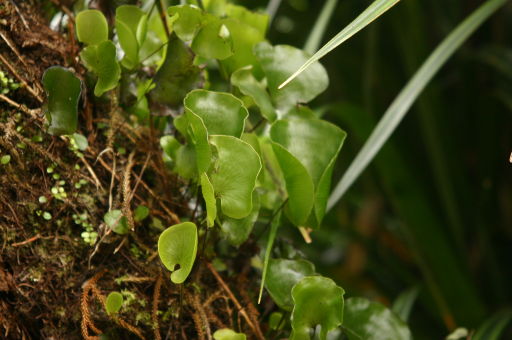
|
|
Kidney fern on a vegetation-covered trunk (big image, small) |




After breakfast, we piled into the bus for a quick ride to a parking place that was departure point for two short and tourist-friendly walks.
The first and shorter of these was through a swampy area, with some huge Kahikatea trees (Dacrycarpus dacrydioides), one of the many podocarps here, which was used for making boxes for exporting butter in because of its complete lack of odor. Like many of the trees endemic to New Zealand, though, it’s not a fast grower, and now is almost totally protected from logging.
So what do you do if you need lumber, but your native trees are pretty much unsuitable for sustainable forestry? Just as has happened in Chile, the fast-growing North American tree Monterey Pine (Pinus radiata) has been imported into New Zealand for commercial logging; and just as in Chile, that tree has escaped and become something of a curse.
|
|
I found this wetter morning walk really thrilling. The sight of such a profusion and riot of vegetation set my California gardener’s mind spinning. Such pity we can’t grow ferns like the ones in the upper left snapshot (big image, small)!
The second walk was through higher and drier terrain, dominated by Rimu (Dacridium cupressinum) rather than Kahikatea. The left picture in the top row, to the left (big image, small) shows a view out over this terrain, taken from a high observation platform that we stopped at. The day was gray, and the colors rather muted.
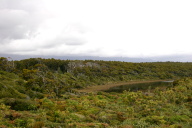
|
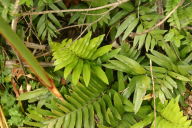
|
Naturally I took lots of pictures of ferns. Almost everything in the lower picture (big image, small) is some kind of fern, except for the blade of New Zealand Flax at the left edge, and the somewhat wood-sorrely looking little leaves at the lower left corner.
We came out of the woods onto a beach of mostly small pebbles—sandy in only a few places—and stood for a while as dolphins showed their fins, swimming in an undulating path not at all far out into the water. I held my camera in wait for the appearane of a dorsal, but never once caught anything. People said that a couple of them breached completely, but I never saw that at all.
Off the beach and onto the bus for a short ride to the Hard Antler Café, where we had what Nicky considered the best possible fish and chips. The fish was fresh indeed, black cod, but the whole meal was a bit greasy for my overrefined palate.
Next, back onto the bus for about an hour’s drive along the Haast River, and continuing inland, across the divide so that we would be in much drier surroundings; and then to the head of a trail that Nicky described as easy. The plan was that she would drive to the end of the trail and leave the bus there, then walk up to meet us midway.
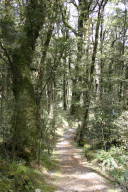
|
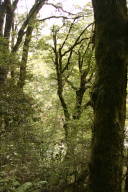
|
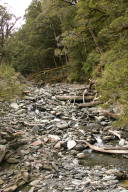
|
The trail was easy in the sense that there was no way we could make the mistake of getting off it, but it was a steady downhill walk, and put a certain amount of strain on knees and knee muscles. I was glad I had my walking stick, even if it was somewhat crooked.
The left picture to the left shows the trail we walked down (big image, small), though I guess the slope isn’t so obvious here. But we now were on the other side of the divide, so the surroundings here were much drier than before lunch, as you can see in all the pictures of this group. Even the middle picture (big image, small), with a Rimu’s trunk, I presume, at its right-hand edge, shows the relative sparseness of the forest here, even though the epiphytic growth on the tree is still notable.
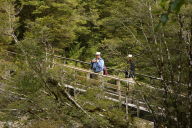
|
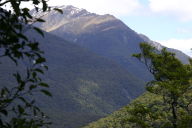
|
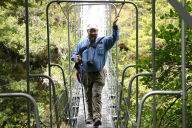
|
As I recall, Nicky remarked several times that the weather had been relatively dry here for a while; this would explain the almost dry stream bed shown in the rightmost view (big image, small); somewhat before taking that shot, I caught Mark and Tom standing on the unusually stable swing bridge (top picture to the right, big image, small)—on this one at least, Mark would not be likely to be affected by any nervousness. So there he and Tom are, Mark getting ready to photograph the stream below.
The path was fairly high up at the beginning, and we had some good views onto the distant mountains, as in the middle view to the right (big image, small). There was one more swing bridge on the trail, and the last picture in that column shows Mark looking rather pleased, just having negotiated it. (Big image, small.) We continued our walk along the Makarora, which flows into Lake Wanaka, but none of my pictures of this river are interesting in the least.
The very last picture I took this day was at the end of our walk, I believe, just before we hopped onto the bus to drive to Wanaka.
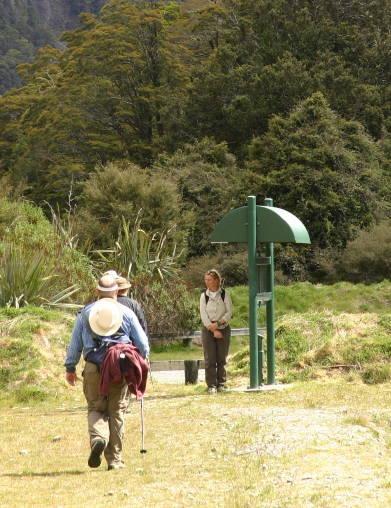
|
|
End of the Trail (Big image) |
The town of Wanaka itself was very pleasant: small, but with a number of nice shops, and with a couple of restaurants that Nicky could recommend to us. We walked the mile or so from our hotel to Missy’s Kitchen, a pleasant unpretentious place with very good food. The five of us Walkers all decided to meet there, and we shared two bottles of local Pinot Noir as accompaniment to our meal. The tab for the whole thing was NZD80.00 per person, so just $60.00, eminently reasonable for that kind of fare. Yum.
Next day’s pictures, previous day’s pictures. Return to the central New Zealand page; to the central travel page; to my home page.